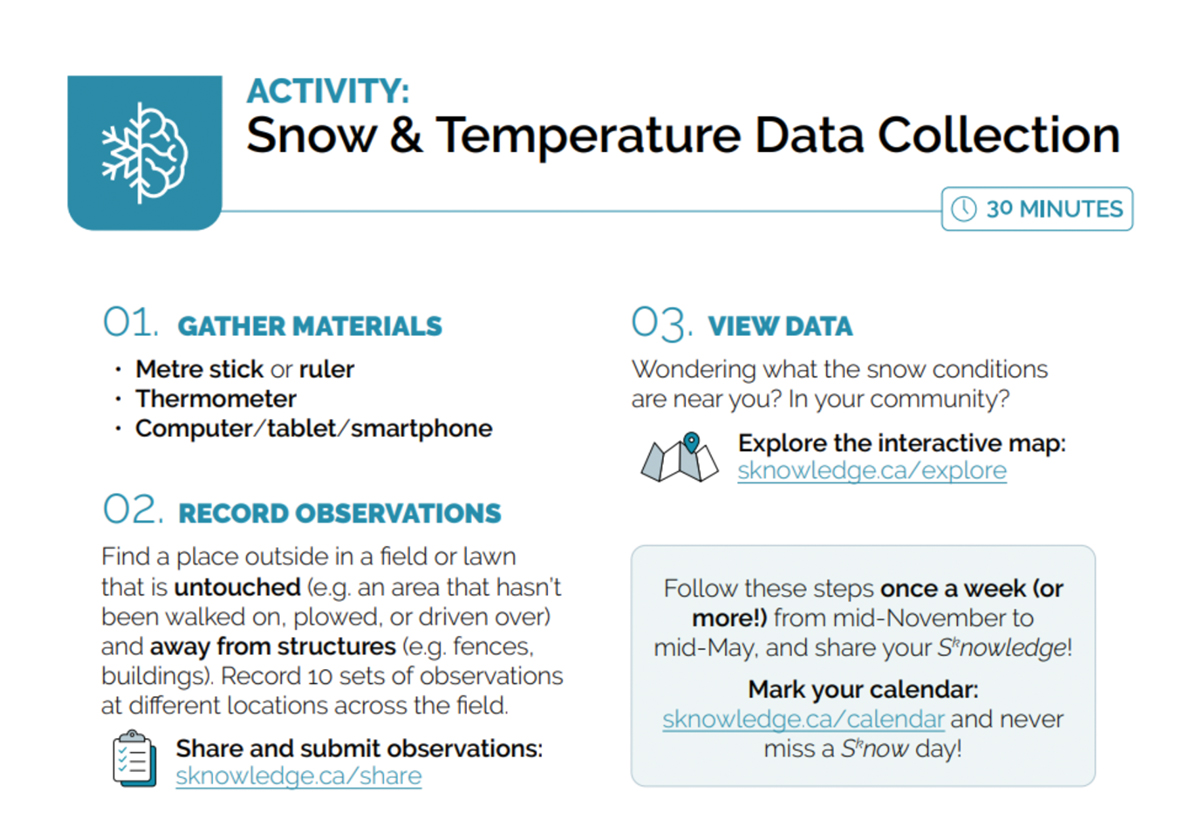Citizen science
Get in the “Sknow” for Science!
Science Scope—November/December 2022 (Volume 51, Issue 2)
By Jill Nugent
Think back to your childhood memories surrounding the excitement for the first snowfall of the season, along with the anticipation of successive winter snowfall events and wondering if the next day might be a snow day. The Sknowledge Collective (Sknowledge is short for snow knowledge) was developed based on student interest in winter weather. Launched in 2020 from the University of Toronto, the Sknowledge project was formed around the natural curiosity that students have for the outdoors and for snow. The project was designed with science and education in mind and provides an abundance of resources for use in the classroom (see “Sknowledge resources” under “Helpful Project Links”). Students will have the opportunity to engage in hands-on collaborative science in the outdoor classroom as they collect data on snow depth, air temperature, cloud cover, and even the ability to make a snowball!
The data that students collect and share will help to validate satellite data and provide greater insight into questions related to climate, weather, and hydrological processes. Students will help meteorologists ground truth winter weather data and compare ground level data with satellite data and imagery. Students will learn about winter weather, change over time, and local variability of snow levels.
Project goal: To help scientists ground truth winter weather data, one snowball at a time
Task: Measure snow depth, air temperature, and cloud cover, and make a snowball
Science discipline: Earth and Environmental Science
Starting in mid-November and lasting until mid-May, classrooms are invited to go outside once per week and record snow depth, air temperature, and cloud cover, using tools such as a ruler (or meter stick) and thermometer. Students will also be able to test their ability to make a snowball across the various locations where the data are collected. In addition to the schoolyard, students can also collect data in the community, their backyard, local parks, and more. The project provides a helpful getting-started guide, which includes a three-step overview outlining how to participate in the project (see Figure 1). The project also includes resources to support science engagement at home—providing a natural activity for a winter snow day!

The Sknowledge Project provides free online resources for the classroom, and its quick start guide summarizes three steps to participate.
Materials you will need:
- ruler or meter stick
- thermometer
- access to a computer
- access to an outdoor site with snow
Sknowledge is an ideal project to do during the snowy months of the school year, and it also provides opportunities to connect science practices and crosscutting concepts. Students will investigate the natural world as scientists do and construct a scientifically based understanding of the world around them. The citizen science project fosters connections to science and skills including measuring, graphing, mapping, and more. This can lead to a “snowball” effect for interest and engagement in learning and doing science across all seasons!
Those who live in an area without snow can take part by exploring the online interactive map and the data collected and shared by others; additionally, the project provides a helpful Sknowledge resources page (see Helpful Project Links) on its website that provides connections, activities, and extensions related to the project topic. •
Sknowledge at a glance
When: Mid-November through mid-May
How: Visit the project’s “Getting Started” page (see “Helpful Project Links”) and gather materials, collect measurements outdoors, and record your observations online.
Where: Outdoors and online
Time needed: Seasonally, once per week
Special equipment needed: None
Cost: No cost to participate
Contact for more information: https://bit.ly/3EvTWub
Safety: As with any science lab, classroom, or field activity, always ensure that you are following recommended safety practices; for more information on safety in the science classroom visit www.nsta.org/safety.
HELPFUL PROJECT LINKS
Project home—https://www.sknowledge.ca/
Project link on SciStarter—https://bit.ly/3VgY4Ux
Sknowledge getting started—https://bit.ly/3T9amwr
Sknowledge resources—https://bit.ly/3EvFqCE
Sknowledge videos—https://bit.ly/3COgIw8
Jill Nugent (jillfnugent@gmail.com) teaches science online, engages educators in citizen science experiences for the classroom, schoolyard, and beyond, and serves on the SciStarter Team. Follow SciStarter on Twitter: @SciStarter.
This column is the result of a partnership between SciStarter and the National Science Teaching Association. For more information about SciStarter and other citizen science projects, please visit www.scistarter.org.
Citizen Science Earth & Space Science Instructional Materials Middle School


